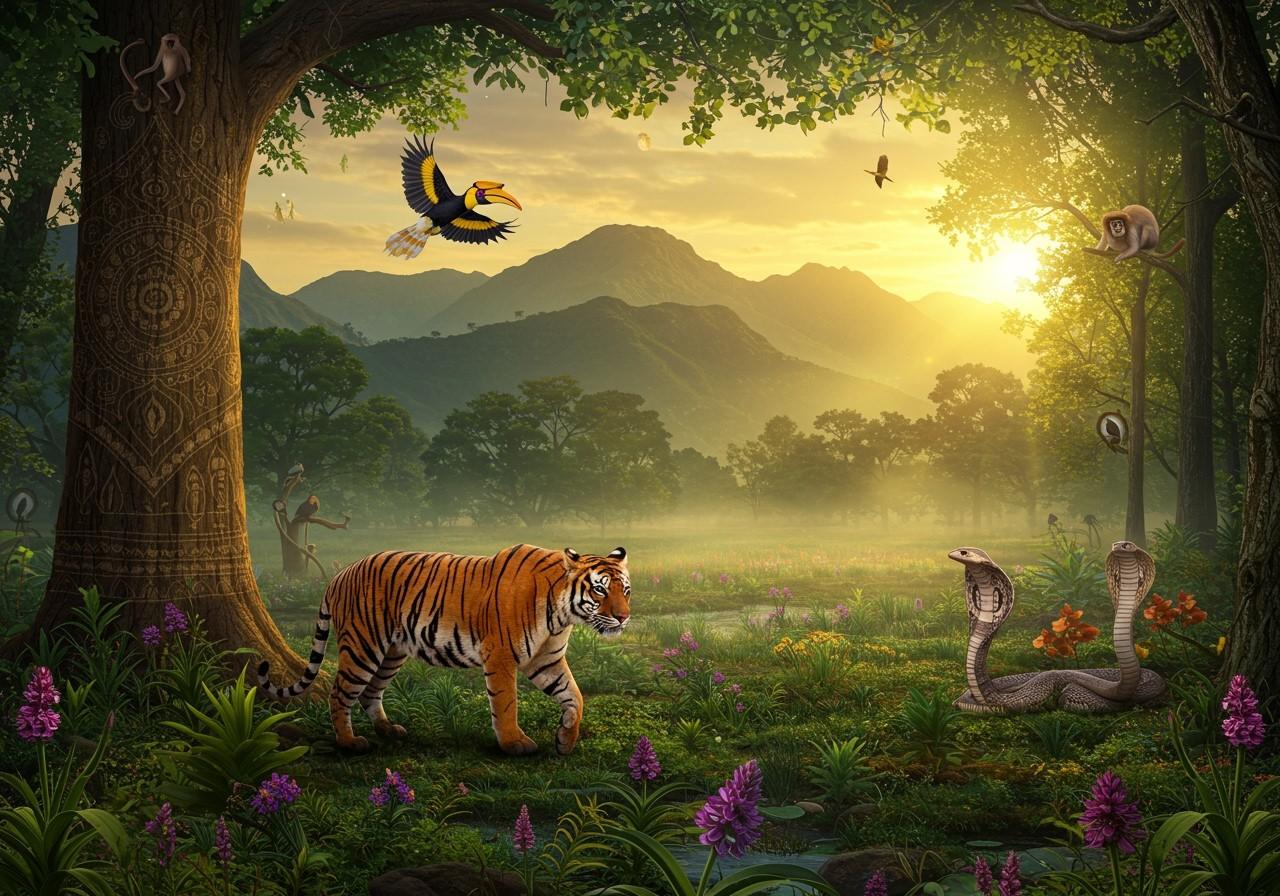
Karnataka, a state in southern India, is renowned for its incredible biodiversity. From the lush Western Ghats to the dry scrub jungles, Karnataka is a haven for a wide array of plant and animal life. This rich biodiversity also plays a significant role in the state’s cultural and spiritual traditions, with many native plants used in sacred rituals. This article delves into Karnataka’s diverse ecosystems, exploring its national parks, wildlife sanctuaries, unique flora and fauna, and the importance of conservation efforts. Karnataka is a popular destination for wildlife tourism, offering numerous national parks, wildlife sanctuaries, and bird sanctuaries. The state’s wildlife tour spans from the lush Western Ghats to the scrub jungles of the plains. Karnataka is known for its excellent eco-tourism and wildlife conservation services. Visitors can enjoy jungle safaris and explore various hidden gems, including heritage sites, temples, monuments, beaches, and adventure activities.
Karnataka’s National Parks
Karnataka boasts several prominent national parks, each offering a unique glimpse into the state’s diverse ecosystems:
- Bandipur National Park: Famous for its thriving tiger population, Bandipur also boasts a rich variety of flora and is an important part of the Nilgiri Biosphere Reserve. It offers exciting safari experiences for visitors.
- Bannerghatta National Park: Located near Bangalore, this park offers a convenient escape into nature. It features a zoo, a butterfly park, and safari opportunities, making it an ideal destination for a day trip.
- Nagarhole National Park (Rajiv Gandhi National Park): Known for its significant elephant and leopard populations, Nagarhole is a crucial part of the Nilgiri Biosphere Reserve. The park is also home to several other mammal species, including tigers, dholes, and gaurs.
- Kudremukh National Park: Situated in the Western Ghats, this park is characterized by its stunning mountainous terrain and rich biodiversity. It’s a haven for trekkers and nature enthusiasts.
- Anshi National Park: Part of the Kali Tiger Reserve, Anshi National Park is home to several rare and elusive species, including the black panther. The park’s dense forests and diverse landscapes provide crucial habitat for a variety of wildlife.
These parks are vital for conservation efforts and offer a variety of tourist activities, including safaris, bird watching, and nature trails.
Karnataka’s Wildlife Sanctuaries
Beyond national parks, Karnataka is home to numerous wildlife sanctuaries that protect a wide range of species:
- Dandeli Wildlife Sanctuary: A birdwatcher’s paradise, Dandeli also offers thrilling river rafting experiences. The sanctuary is known for its diverse avifauna, including the Malabar pied hornbill and the great Indian hornbill.
- Bhadra Wildlife Sanctuary: Known for its tiger and elephant populations, Bhadra is an integral part of Project Tiger. The sanctuary also provides habitat for other endangered species, such as the Indian giant squirrel and the slender loris.
- Ranganathittu Bird Sanctuary: A must-visit for ornithologists, Ranganathittu boasts a large population of migratory birds. Located on the banks of the Kaveri River, the sanctuary provides an ideal nesting ground for various bird species.
- Cauvery Wildlife Sanctuary: Famous for its diverse aquatic life and angling opportunities, Cauvery Wildlife Sanctuary protects a vital section of the Cauvery River ecosystem. The sanctuary is home to a variety of fish species, otters, and marsh crocodiles.
These sanctuaries play a crucial role in wildlife conservation and promote responsible tourism practices through eco-tourism initiatives.
The Western Ghats in Karnataka
The Western Ghats, a UNESCO World Heritage Site, are essential to Karnataka’s biodiversity. This mountain range harbors numerous endemic plant and animal species, helps maintain ecological balance, regulates water flow, and moderates the climate. Notable flora includes the unique Nilgiri hills vegetation, while fauna like the Malabar giant squirrel and the endangered lion-tailed macaque call this region home. Ongoing conservation efforts aim to protect this vital ecosystem from threats like deforestation and climate change.
Unique Flora of Karnataka
Karnataka’s diverse plant life includes several endemic and rare species. The state is renowned for its sandalwood trees, whose aromatic wood is used in traditional rituals and crafts. Medicinal plants like Ashwagandha and Brahmi, essential to Ayurveda, also thrive here. The Western Ghats nurture unique flora such as the Neelakurinji, a flower that blooms only once every twelve years.
Unique Fauna of Karnataka
Karnataka’s wildlife includes rare and endangered species. The state is known for its tiger reserves, particularly in Bandipur and Nagarhole National Parks. The Indian elephant is another significant species found in Karnataka. The diverse birdlife includes the Malabar pied hornbill and the Great Indian bustard. Conservation efforts focus on protecting endangered species like the lion-tailed macaque and critically endangered amphibians of the Western Ghats.
Karnataka Wildlife Tourism
Karnataka’s rich biodiversity provides numerous opportunities for wildlife tourism. Safaris are available in national parks like Bandipur and Nagarhole. Eco-tourism initiatives in sanctuaries like Dandeli and Cauvery promote responsible tourism. Unique experiences like bird watching in Ranganathittu and river rafting in Dandeli offer memorable adventures while contributing to conservation.
How Poojn Supports Karnataka’s Sacred Flora
Karnataka’s rich biodiversity includes many sacred plants used in traditional Hindu rituals. Poojn.in offers a variety of products incorporating these sacred plant materials, sustainably sourced from Karnataka’s forests and farms:
Hawan Samagri Products:
- Drolia’s Pavitra ebam Sugandhit Hawan Samagri utilizes native Karnataka herbs and woods, including sacred ingredients like sandalwood, neem, and tulsi grown in the region. Available in convenient 200g packs, this product offers authentic regional ingredients for your Hawan ceremonies.
Puja Items with Local Materials:
- Kumkum made from naturally grown turmeric from Karnataka.
- Pure camphor sourced from regional producers.
- Dhoop and agarbatti containing locally sourced aromatic herbs.
Benefits of Choosing Poojn Products:
- Supports the sustainable harvesting of Karnataka’s sacred plants, ensuring the preservation of these valuable resources.
- Maintains traditional connections to local biodiversity, honoring the cultural significance of native plants. Provides authentic regional puja materials with the convenience of online shopping.
- Ensures high quality through careful sourcing from verified suppliers, guaranteeing the purity and authenticity of your puja items.
Visit poojn.in to discover these authentic Karnataka-sourced puja items. Each purchase contributes to the preservation of traditional knowledge of sacred plants while supporting sustainable practices in the region’s rich biodiversity zones.
Conclusion
Karnataka’s rich biodiversity is a treasure trove of natural and cultural significance. Its national parks, wildlife sanctuaries, and the majestic Western Ghats play a crucial role in safeguarding this unique flora and fauna. Responsible tourism and dedicated conservation efforts are essential to protect this invaluable heritage for future generations. Embrace the opportunity to explore Karnataka’s wildlife and contribute to preserving its natural splendor.
FAQs on Karnataka’s Flora and Fauna
What are some popular national parks in Karnataka? Bandipur, Nagarhole, Bannerghatta, and Kudremukh are among Karnataka’s most popular national parks.
Which wildlife sanctuaries are located in Karnataka? Karnataka is home to several wildlife sanctuaries, including Bhadra, Dandeli, Cauvery, and Brahmagiri.
Why are the Western Ghats a biodiversity hotspot? The Western Ghats harbor a remarkable concentration of endemic plant and animal species, fostered by the region’s unique climate and geography.
Is it possible to see tigers in Karnataka’s wildlife parks? Yes, tigers can be spotted in Bandipur and Nagarhole National Parks, among others.
What types of plants are found in Karnataka’s forests? Karnataka’s forests boast a diverse range of flora, including teak, sandalwood, rosewood, bamboo, medicinal plants, and rare orchids.
Are there good locations for bird watching in Karnataka? Ranganathittu Bird Sanctuary, Kokrebellur, and Gudavi Bird Sanctuary are excellent bird-watching destinations in Karnataka.
How can I visit Karnataka’s national parks and wildlife sanctuaries? Guided tours and safaris can be booked to visit these protected areas. Many parks offer accommodations and facilities for visitors.
When is the best time to visit Karnataka’s national parks? The cooler months from October to March offer pleasant weather and increased chances of wildlife sightings, making it the ideal time to visit.


